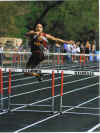2008 SD - AAPT Photo Contest Results

Optical-Illusion Candle
Light is a funny thing. Usually light produces real images, which is an image in which all rays of light intersect at one real point. But, in some cases, light can be reflected to produce virtual images, which are images formed by light rays that only appear to intersect. We see that in this picture of the two candles that appear to be lit. You would have never have guessed it, but the second candle (the one that is furthest away) is not even lit. Even though it is a reflection, the pane of glass acts like a flat mirror. Flat mirrors produce a virtual image of an object that is located the same distance behind the mirror as the actual object is in front of the mirror. The closer candle's reflection through the pane of glass makes it appear that the second candle is also lit. Glass also allows some light to pass through; you are actually seeing the second candle in the picture but light also reflects some light, which is how the flame appears to be lit on top of the second candle.
Inertia
In my photo, you are seeing me on a 1993 ski-doo 583 Formula Z leaving a snow embankment or ledge. As you can see in the picture the snowmobile is falling back towards the ground. I thought that it was very interesting that I could determine the amount of time I was in the air by using the formula H= ½gt2. I measured the highest point at exactly 1.4 meters. By working out the problem you can come to the conclusion that the snowmobile was in the air for approximately .53 seconds. Normally most people wouldn’t relate this to physics, but it has everything to do with physics. Physics is all around us, and this project has allowed me to relate some of the skills and formulas I have learned to real life situations

Projectile Motion, Momentum & Center of Gravity Hurdler
For this picture, I examined the physics of a person jumping over a track hurdle. This picture shows the person as being similar to a projectile launched at an angle. The runner should adjust this launch angle for the height of the hurdles. If the hurdles are higher, the angle should be greater than 45 degrees, so that the vertical component of their jump is greater than the horizontal component and gets them over the hurdle. For lower hurdles, the angle could be less than 45, so that the horizontal component is greater than the vertical. With a greater horizontal component, they can jump farther over the hurdle. Momentum is also an aspect of hurdling. Running full speed would build up momentum to go over the hurdle. The faster you are running, the more momentum you have; you can jump farther back from the hurdle to avoid hitting it and you can get over it quickly. The person's center of gravity affects the runner, too. The runner uses their arms to keep their center of gravity stabilized. The correct position is to have your lead arm bent in front of you. If your arms are not in the correct position, your center of gravity is changed and you could lose your balance. This is the physics of hurdling.